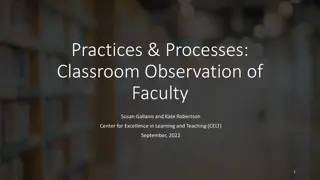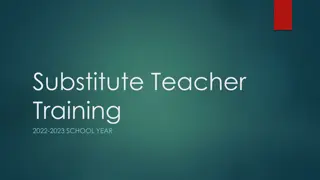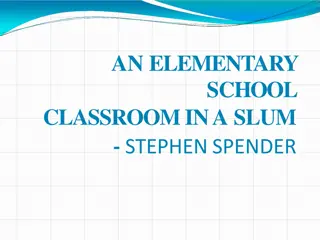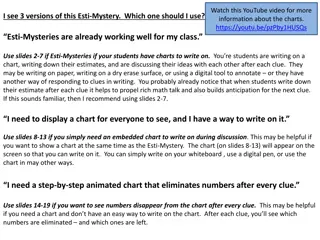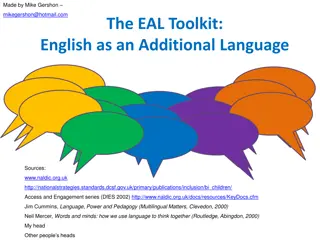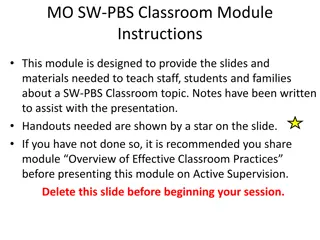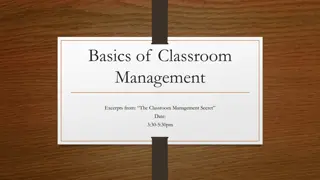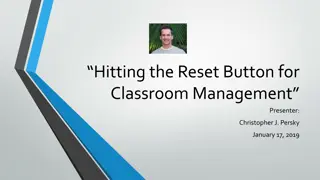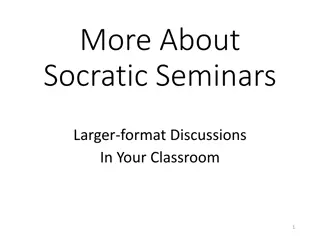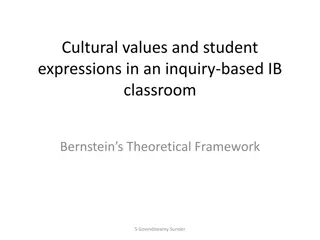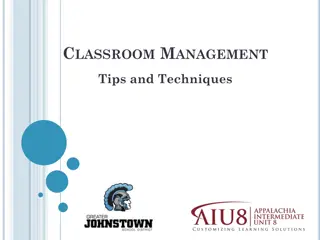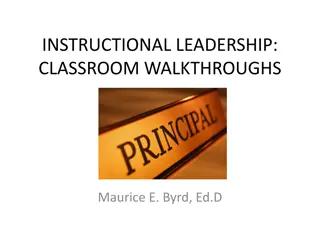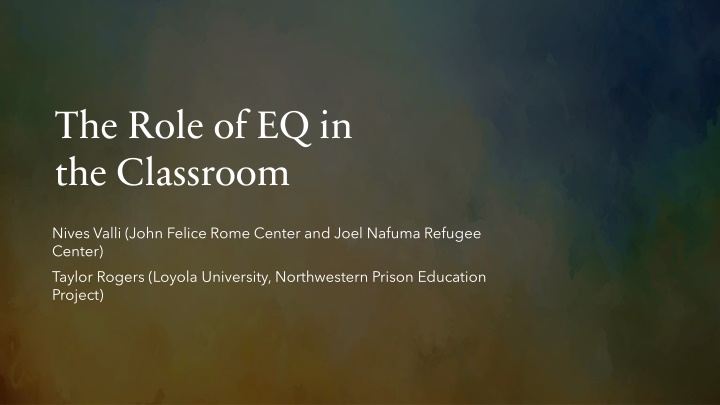
Enhancing Classroom Success Through Emotional Intelligence and Understanding
Explore the vital role of emotional intelligence (EQ) in educational settings, emphasizing the impact of EQ on managing classrooms, fostering student engagement, and lowering barriers to learning. Discover strategies for instructors to enhance empathy, connect with students, and create a supportive learning environment conducive to academic achievement.
Download Presentation

Please find below an Image/Link to download the presentation.
The content on the website is provided AS IS for your information and personal use only. It may not be sold, licensed, or shared on other websites without obtaining consent from the author. If you encounter any issues during the download, it is possible that the publisher has removed the file from their server.
You are allowed to download the files provided on this website for personal or commercial use, subject to the condition that they are used lawfully. All files are the property of their respective owners.
The content on the website is provided AS IS for your information and personal use only. It may not be sold, licensed, or shared on other websites without obtaining consent from the author.
E N D
Presentation Transcript
The Role of EQ in the Classroom Nives Valli (John Felice Rome Center and Joel Nafuma Refugee Center) Taylor Rogers (Loyola University, Northwestern Prison Education Project)
Introductions Please tell us your name, department , and one word you associate with the idea of emotional intelligence (EQ)
We're being judged by a new yardstick: not just by how smart we are, or by our training and expertise, but also by how well we handle ourselves and each other. (Daniel Goleman, Working with Emotional Intelligence)
Low Emotional Intelligence Not being able to recognize emotions in ourselves as well as in others, will prevent us from managing the classroom because we are not able to connect with students and understand their reactions and mindset. If we are disconnected from our own emotions and lack of emotional self- awareness, we are not able to recognize and manage our emotional reactions toward students. Lack of empathy can lead to mistrust and doubts toward students and can increase the affective filter.
Motivation, self-confidence, and anxiety all affect language acquisition, in effect raising or lowering the "stickiness" or "penetration" of any comprehensible input that is received. (Stephen Krashen s Second Language Acquisition Theory) The Affective Filter Negative affective factors such as anxiety, lack of motivation, low self-esteem, the fear of speaking up in front of a group and being viewed as less intelligent can create walls that prevent students from learning
How can instructors lower the imaginary walls built by negative affective factors and create a comfortable learning environment?
When instructors can read and understand students emotions, stress and reactions, they are able to manage the classroom with compassionate and motivating approaches that help student s achievement. Benefits of EQ in the classroom Active listening and empathy help professors to connect with students and build trust and respect between them. A better understanding of student s behavior and needs helps instructors to motivate students to learn effectively in a comfortable environment, lowering the affective filter.
Students perceptions Professor expressed genuine interest in our lives, encouraging us to tell stories. She makes everyone feel welcome and excited about learning Italian. I knew I could ask for help when needed. Great professor open minded and always wanting to hear what her students thought bright and nice spirit. She was so willing to help us and always encouraged participation.
What compassionate strategies do you think can facilitate students learning? Jamboard Activity
Cooperative learning/teamwork Some strategies to help students develop their EQ Allowing them to make mistakes and learning from them Teaching them to help others (e.g.,. service learning, volunteering etc. ) Developing active listening skills (e.g., learning how to genuine listening and responding in a dialogue) Developing self-awareness skills (e.g., self evaluation questionnaire)
How instructors can help students with mental health disorders using their EQ Paying Attention Paying attention and recognizing the disorder that are not so obvious (e.g., eating disorder, depression, anxiety) Recognizing Recognizing warning signs Educating themselves about mental disorders and attending training classes regarding mental issues among students and consulting with mental health experts Educating Creating Creating a supportive teaching environment Accommodating Accommodating them when possible Taking care Taking care of your own mental health
If we consciously bring our awareness to how we are feeling, and consciously observe how we re behaving, then no matter how intense our emotions are, we can still control our actions. (Russ Harris, The Happiness Trap: how to stop struggling and start living)
From bell hooks', From bell hooks', teaching to transgress teaching to transgress As a classroom community, our capacity to generate excitement is deeply affected by our interest in one another, in hearing one another's voices, in recognizing one another's presence. 2. Excitement is generated through collective effort. The classroom remains the most radical space of possibility 3. Education can only be liberatory when everyone claims knowledge as a field in which we all labor. 4. Hearing each other's voices, individual thoughts, and sometimes associating theses voices with personal experience makes us more acutely aware of each other. That moment of collective participation and dialogue means that students and professor respect each other, engage in acts of recognition with one another, and do not just talk to the professor, but to each other. 5. The academy is not paradise. But learning is a place where paradise can be created. The classroom, with all its limitations, remains a location of possibility. In that field of possibility, we have the opportunity to labor for freedom, to demand of ourselves and our comrades, an openness of mind and heart that allows us to face reality even as we collectively imagine ways to move beyond boundaries, to transgress. This is education as the practice of freedom. 1.
In one sentence, write down an answer to the question: "What is Vulnerability?" Collaborative Activity
Take a few minutes to reflect on our session today, writing down one gift and one challenge. Care for the Container Activity
References Freire, Paolo. "Pedagogy of the oppressed (revised)." New York: Continuum (1996). Goleman, Daniel. "Working with emotional intelligence." (1998). Harris, Russ. The happiness trap: Stop struggling, start living. ReadHowYouWant. com, 2011. Haynes, Joanna, and Walter Kohan. "Facilitating and difficultating: The cultivation of teacher ignorance and inventiveness." In Literacies, Literature and Learning, pp. 204-221. Routledge, 2018. Hooks, Bell. Teaching to transgress. Routledge, 2014. Kohan, Walter Omar. The Inventive Schoolmaster: Sim n Rodr guez. Springer, 2015.




